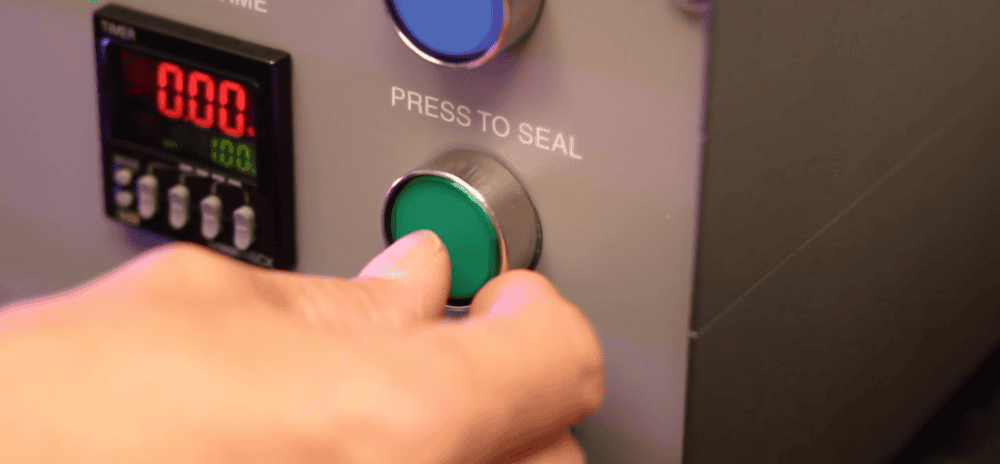 Add My Company
Add My Company

For many products, the impact of packaging on shelf life and product safety is critical to success. Packaging technical teams will carefully specify packaging material characteristics in terms of functional and barrier properties, for example Oxygen Transmission Rate for an oxygen sensitive product. Despite this, the highest risk to pack integrity and shelf life can be failures in the pack heat seals or closures.
Heat Seal parameters are easily measured; Heat Sealability = Temperature + Pressure + Time. Yet maintaining optimum heat sealing conditions in production and recognising the true cause of poor sealing remains a challenge. Measurement of heat sealing parameters is done by creating “controlled seals” on a calibrated Laboratory Heat Sealer according to ASTM F2029, then peeling the seal apart with a Seal Strength Tester at a controlled rate to measure either Ultimate Seal Strength (after cooling, method ASTM F-88) or Hot Tack Strength (peel tested within 150ms of the seal being formed, method ASTM F1921). By varying the sealing temperature and dwell time, the optimum sealing conditions can be found. In studies the third variable, sealing pressure, was found to have little impact after reaching a certain level.
Often product packagers rely on heat seal testing done by their film supplier, or their operators will “turn up the temperature” when seals are not forming consistently, or they’ll run “hot and fast” to increase productivity. This results in a lack of process control, and seal failures throughout the supply chain which can damage brand image and profits. A WRAP Retail Innovations Programme study conducted by University of Lincoln, “Seal integrity and the impact on food waste, Dudbridge, Turner – 2009”, proved exactly these points. They found an average 24% of heat seals at the factory were either already leaky or were ‘at risk’ of integrity failure during some part of the supply chain. The study concluded the most common causes of seal failure were: 1. contamination, 2. sealing parameters and 3. mechanical failure.
Product packagers who regularly test heat seal parameters of incoming film as part of a well-managed quality system, will transfer the measured parameters to the heat sealing process in production to optimise the sealing conditions. Variations in sealing parameters will be found from film supplier to supplier, roll to roll, and even within a roll. The introduction of new materials with functional and barrier layers has narrowed the tolerances for optimum sealing. Even small variations in sealing parameters can impact the quality of resulting seals, with typical poor quality shown as weak seals, channel leaks, edge leaks, back seal/end seal junction leaks, hardened brittle areas caused by overheating, unsealed areas caused by under-heating.
More incidental sealing quality issues result from contamination of product in the sealing area, especially associated with wet/liquid product and loose particles. Mechanical issues with machinery, such as loose or contaminated sealing bars, worn bearings, damaged sealing bar faces will need attention. A PPM programme of the filling and sealing processes will reduce the incidence, and operating in a culture focused on quality will ensure bad practice does not creep in.
For finished packs, common practice is to perform off-line package integrity quality checks every 15 to 30 minutes. The most common method being a manual squeeze test to feel & see if the pack deflates under the pressure of the operators hand. Other more objective methods include bubble leak testing (submerging packs in a water chamber/vacuum to visually watch for bubbles coming from the inflated pack), inflation testing (packs placed in vacuum chamber to visually check if the inflated pack deflates over a defined time), and blue dye penetration testing (passing a blue dye solution over the seals inside empty packs to observe capillary ingress into seal faults). These methods have the advantage of low capital cost, but are limited to somewhat subjective qualitative pass/fail data.
More objective and quantitative methods include seal strength testing ASTM F2054 (increasing the internal pressure of a pack until seal failure), pressure decay leak testing ASTM F2095, (increase the internal pressure to a fixed level, then measure the deflation rate), leak size testing (changing the internal pressure to a fixed level, then measure the flow to maintain that pressure determining the theoretical hole size in microns according to Hagen-Poiseuille law) and vacuum leak testing (drawing out the pack atmosphere and applying a continuous vacuum again to determine theoretical hole size in microns). These all have the advantage of quantitative measurement, enabling suitable pass / fail limits which correlate with real world conditions or product shelf life, to be set. Measurements recorded over a period of time with the use of an SPC system, will highlight trends in the process.
The demand for on-line seal inspection systems to leak test has led to a range of retrofit and new line options being offered. Technologies include vacuum chambers, gas sniffing, precision squeezing and prodding, visual and laser systems, however leak detection effectiveness of such systems varies widely, and can be dependent on the packaging format, size and headspace volume. Some on-line inspection systems promise an ultimate solution of 100% leak testing every package, however they can be slow and capital costs considerably high.
A different approach to the problem of inconsistent sealing has been developed by a team led by Bart De Ketelaere, PhD.
Eng, Faculty of Bioscience Engineering at The University of Leuven, Belgium. They have patented an on-line seal inspection technology, which is now available across Europe via their commercial partner Engilico. The system monitors the ‘fingerprint’ of every seal via a sensor fitted to the sealing bar. The system known as SealScope™ compares the fingerprint to a known mathematic model fingerprint for each pack type which is created by the first 30 seals made. Sealing process failures caused by contamination, creases and folds, misalignment etc. are easily detected and instantly rejected from the line at speeds up to 150 ppm. During a production run, process drift such as a contamination build-up on the sealing bar, is seen in trending data and the software interface alerts operators to rectify the issue before leaky packs are produced.
In conclusion, many thousands of pounds are spent designing creative packaging for product brands to help sell a product and provide the consumer with an enjoyable experience that they’ll want to repeat.
However, lack of investment in packaging process and quality control can bring that experience crashing down when the product inside the pack has failed due to a shortened shelf life or breached product safety. Basic quality checks such as heat seal parameters, off-line quantitative package integrity testing and now the introduction of on-line seal inspection will give product packagers an advantage in securing greater brand image, less customer complaints and ultimately greater profits.
RDM Test Equipment work with material developers, converters, and product packagers, who are interested in controlling physical properties of materials and finished packages. By helping them to avoid costly quality failures and productivity downtime, they enjoy greater profitability, and their customers enjoy repeatable product packaging.
For more information on How to avoid quality control inspection issues, focusing on Heat Seal Parameters. talk to RDM Test Equipment Ltd



